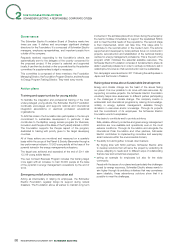APC 2011 Annual Report Download - page 87
Download and view the complete annual report
Please find page 87 of the 2011 APC annual report below. You can navigate through the pages in the report by either clicking on the pages listed below, or by using the keyword search tool below to find specific information within the annual report.
REGISTRATION DOCUMENT 2011 SCHNEIDER ELECTRIC 85
SUSTAINABLE DEVELOPMENT
2
SCHNEIDER ELECTRIC, A RESPONSIBLE CORPORATE CITIZEN
It will also give them the ability, should they wish, to sell and maintain
energy access offers and to create their own small business in time.
Furthermore they are a vital and indispensable element for all
responsible and sustainable rural electrifi cation policies.
Schneider Electric’s strategy for the training of disadvantaged
groups at the base of the pyramid includes three key priorities:
•basic training that is relatively short, free and accessible to a large
number of people; full-time or evening and weekend courses to
be able to better adapt to the local situation;
•training leading to qualifi cations in partnership with local Ministries
of Education, included within the bilateral guidelines;
•training for trainers to support effective and quality roll-out of
training down the line, accompanied by fi nancing for investments
in materials.
These actions are funded by the Schneider Electric Foundation
and are systematically implemented in partnership with local actors
and/or national or international organisations (NGOs, governments,
etc.).
Action plans
In 2011, Schneider Electric set as a priority the optimisation and
rationalisation of existing projects to prepare to extend them on a
larger scale during the period 2012 to 2014. This was particularly
the case for its three major projects in India, Brazil and Lebanon.
Furthermore, this ambition was maintained on its other projects and
at the end of 2011 there were 19 projects that contributed to the
development of knowledge in electricity in 16 countries and opened
the way to employment for billions of people.
The new targets had also been explored in 2011 to reinforce the
effectiveness of projects implemented in our partner centres:
•direct donation of materials (in Haiti and in Tanzania);
•development of low-cost didactics materials adapted to the
technical and economic reality of countries at the base of the
pyramid (fi rst prototype in November2011);
•support of micro-enterprise creation by young adults coming
from partnership training centres (50 in India in 2011).
2012 will be the year of supporting the growth of existing projects
whilst proving their effectiveness. The target will be to train more
than 10,000 new people during the year.
This year will also see the fi rst experimentation in transnational
duplication (Lebanon to Morocco/Nigeria, India to sub-Saharan
Africa, Tanzania to the East African Community).
Projects started in 2010 will be fully underway in 2012:
•launch of a BipBop Education didactic materials range;
•implementation of a materials donation process to extend this
action;
•support of at least 150 new self-starting entrepreneurs in
India and experimentation with the model in new countries
(Haiti,Cambodia).
Due to the fact that the complimentary factor could be an even
more effective factor in helping populations at the base of the
pyramid, research on a more voluntary basis by partnerships with
the companies sharing Schneider Electric’s values will be started
in 2012. This may lead to opening our existing projects to new
partners or to co-construction of new projects with them.
5.2 The Schneider Electric Foundation
Approach
Created in 1998 under the aegis of Fondation de France, the
Schneider Electric Foundation is involved in three main programs:
•training and employment opportunities for young adults from the
base of the pyramid trained primarily in the electrical profession;
•support for emergency and post-emergency relief efforts after
natural disasters;
•raising sustainable development awareness through innovative
projects.
The Foundation carries out its work through a network of 120
employee volunteers, known as delegates. These volunteers, who
are located in more than 70 countries, are responsible for identifying
local partnerships, presenting them to employees in their units, and
to the Foundation and tracking projects once they are launched.
Each project is subject to a review process based on administrative
and fi nancial data by the Schneider Electric Foundation and by
Fondation de France before funds are released.
With an annual budget of EUR4million, the Foundation works to
support its partnerships through Schneider Electric entities in which
employees are also involved. A total of EUR12.4million have been
invested in this way to benefi t local communities (see page105 ).
Organisation
The Foundation’s network structure is an original and very suitable
means for engaging local, humane, and lasting sponsorship. It
also reinforces the energy of the people involved. In each site, the
choice of delegates is made based on recognised and formalised
participation via a letter of engagement signed by the head of the
site and that of the Foundation for a duration of two years. In 2011,
the Foundation had 120 delegates in 70 countries for a mission,
which includes:
•selecting an association dedicated to employing young adults
and supporting this partnership;
•organising local events adapted to the country’s culture, to better
boost employee morale;
•informing employees of Foundation activities at their site.
The delegates also coordinate the organisation of the annual
campaign for international mobilisation called Luli. This week takes
place in June and is an important time in the life of the Foundation
and the company with local partnerships taking centre stage at an
international level.
























